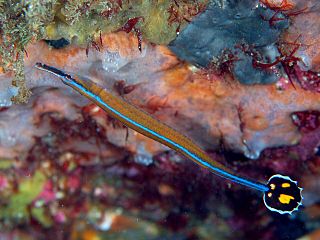
A seahorse is any of 46 species of small marine fish in the genus Hippocampus. "Hippocampus" comes from the Ancient Greek hippókampos (ἱππόκαμπος), itself from híppos (ἵππος) meaning "horse" and kámpos (κάμπος) meaning "sea monster". Having a head and neck suggestive of a horse, seahorses also feature segmented bony armour, an upright posture and a curled prehensile tail. Along with the pipefishes and seadragons they form the family Syngnathidae.

The Syngnathidae is a family of fish which includes seahorses, pipefishes, and seadragons. The name is derived from Greek, σύν (syn), meaning "together", and γνάθος (gnathos), meaning "jaw". This fused jaw trait is something the entire family has in common.

Pipefishes or pipe-fishes (Syngnathinae) are a subfamily of small fishes, which, together with the seahorses and seadragons, form the family Syngnathidae.
The longsnout pipefish is a pipefish of the family Syngnathidae. It has only been recorded from midwater and bottom trawls at depths of 37–212 metres (121–696 ft). The habitat and biology of this species are almost unknown but juveniles have been recorded in the stomachs of blue penguins and Snares penguins.

The greater pipefish is a pipefish of the family Syngnathidae. It is a seawater fish and the type species of the genus Syngnathus.

Doryrhamphus and Dunckerocampus, popularly known as flagtail pipefish, are two genera of fishes in the family Syngnathidae. They are found in warm, relatively shallow waters of the Indo-Pacific, with a single species, D. paulus, in the eastern Pacific. Most of these pipefishes are very colourful, and are fairly popular in the marine aquarium hobby despite requiring special care and not being recommended for beginners.

The alligator pipefish or double-ended pipefish is a species of fish in the family Syngnathidae and is the only species in the monotypic genus Syngnathoides. It is found in shallow water in the tropical and subtropical Indo-Pacific, its range extending from East Africa to northern Australia. This fish lives in habitats of seagrass and seaweed, and hides by positioning itself vertically with its head down amidst the similar-coloured fronds of vegetation. The elongated, well-camouflaged body can reach 29 cm (11 in) in length. It feeds by sucking up its prey.

Dunckerocampus is a genus of pipefishes one of two genera known as the flagtail pipefishes. This genus is native to the Indian and Pacific Oceans where they are usually found in reef environments. These species are elongated and have a maximum length between 10 and 20 centimetres, with D. chapmani being the only species with a maximum length below 15 centimetres (5.9 in). Their tail is red with a whitish edge, and in some species there is a white or yellow spot in the center. All except D. baldwini have vertical red/brown and yellow/white stripes on their body.

Doryrhamphus is a genus of pipefishes, one of the two genera colloquially known as flagtail pipefishes and are popular in the aquarium trade. The members of this genus are native to the Indian and Pacific Oceans where they inhabit reef environments. The species in this genus have a maximum length of 14 centimetres (5.5 in) or less, with D. janssi being the only species that surpasses 8.5 centimetres (3.3 in). Most species have a horizontal blue line along their body, and all have a whitish-edged tail that is marked contrastingly with black, red or yellow.

The Hippocampinae are a subfamily of small marine fishes in the family Syngnathidae. Depending on the classification system used, it comprises either seahorses and pygmy pipehorses, or only seahorses.
Halicampus is a genus of pipefishes of the family Syngnathidae, containing 12 described species.
Choeroichthys is a genus of pipefishes of the family Syngnathidae native to the Indian and Pacific Oceans.

Doryrhamphus excisus is a species of flagtail pipefish from the genus Doryrhamphus. Its common names include blue-striped pipefish and blue-and-orange cleaner pipefish. The fish is found throughout much of the Indo-Pacific and tropical East Pacific.

Charles Eric "Chuck" Dawson was a Canadian-American ecologist, ichthyologist, and taxonomist. He held expertise in gobies, flatfishes, and sand stargazers, and was considered "the ultimate authority" on pipefishes in the family Syngnathidae.

Stigmatopora argus, the spotted pipefish, is a species of ray-finned fish from the family of pipefish and seahorses (Syngnathidae). The scientific name of the species is the first validly published in 1840 by Richardson.

Choeroichthys brachysoma is a species of marine fish of the family Syngnathidae. It is found in the Indo-Pacific, from the Red Sea and East Africa to the Society Islands, the Philippines, Guam, and northern Australia. It inhabits tide pools, seagrass, rocky coastlines, mangroves, and coral reef areas at depths of 2–25 metres (6.6–82.0 ft), where it can grow to lengths of 7 centimetres (2.8 in). C. brachysoma shows sexual dimorphism, the females are slender with two rows of black spots along their flanks, while the males have a shorter, wider body marked with scattered, small white spots. This species is ovoviviparous, with males carrying eggs in a brood pouch until giving birth to live young. Males may brood at 3.5–4 centimetres (1.4–1.6 in).
Choeroichthys smithi is a species of marine fish of the family Syngnathidae. It is found in the western Indian Ocean along the coasts of Reunion, Mauritius, the Seychelles, Madagascar, Tanzania, Mozambique, and South Africa. It is a demersal species, inhabiting tide pools and reef flats in coastal waters where it can grow to lengths of 5 cm. This species is ovoviviparous, with males carrying the eggs and giving birth to live young. The specific name honours the South African ichthyologist J.L.B. Smith (1897-1968) who collected the material which was used as the holotype by Dawson when he described the species.
Stigmatopora narinosa, also known as the Southern Gulf pipefish is a species of marine fish belonging to the family Syngnathidae. The species can be found in patches of seagrass and algae in the shallow waters of Spencer Gulf and the Gulf St. Vincent, South Australia. Their diet likely consists of small crustaceans such as copepods and amphipods. Adult males have been measured at lengths up to 11.3 centimeters. Reproduction occurs through ovoviviparity in which the males brood eggs from December to March before giving live birth.
Stigmatopora nigra, also known as the wide-bodied pipefish is a species of marine fish belonging to the family Syngnathidae. This species can be found in the shallow waters, bays, and estuaries of southern Australia from Shark Bay to Brisbane, Tasmania, and New Zealand. They often inhabit seagrass or algae beds in addition to bare sand. Their diet consists of small crustaceans such as copepods and amphipods. Adult brooding males have been measured at 6.5-7 centimeters. Reproduction occurs through ovoviviparity. in which the males brood up to 25 eggs in a pouch below the tail before giving live birth. Stigmatopora nigra can live to 150 days old and are able to reproduce throughout the year.
Stigmatopora harastii, the red wide-bodied pipefish, is a species of ray-finned fish from the family of pipefish and seahorses (Syngnathidae).










